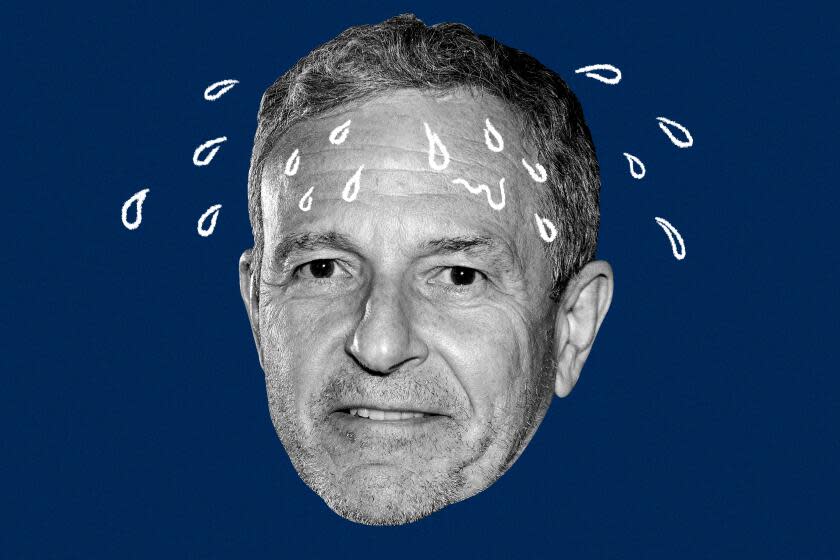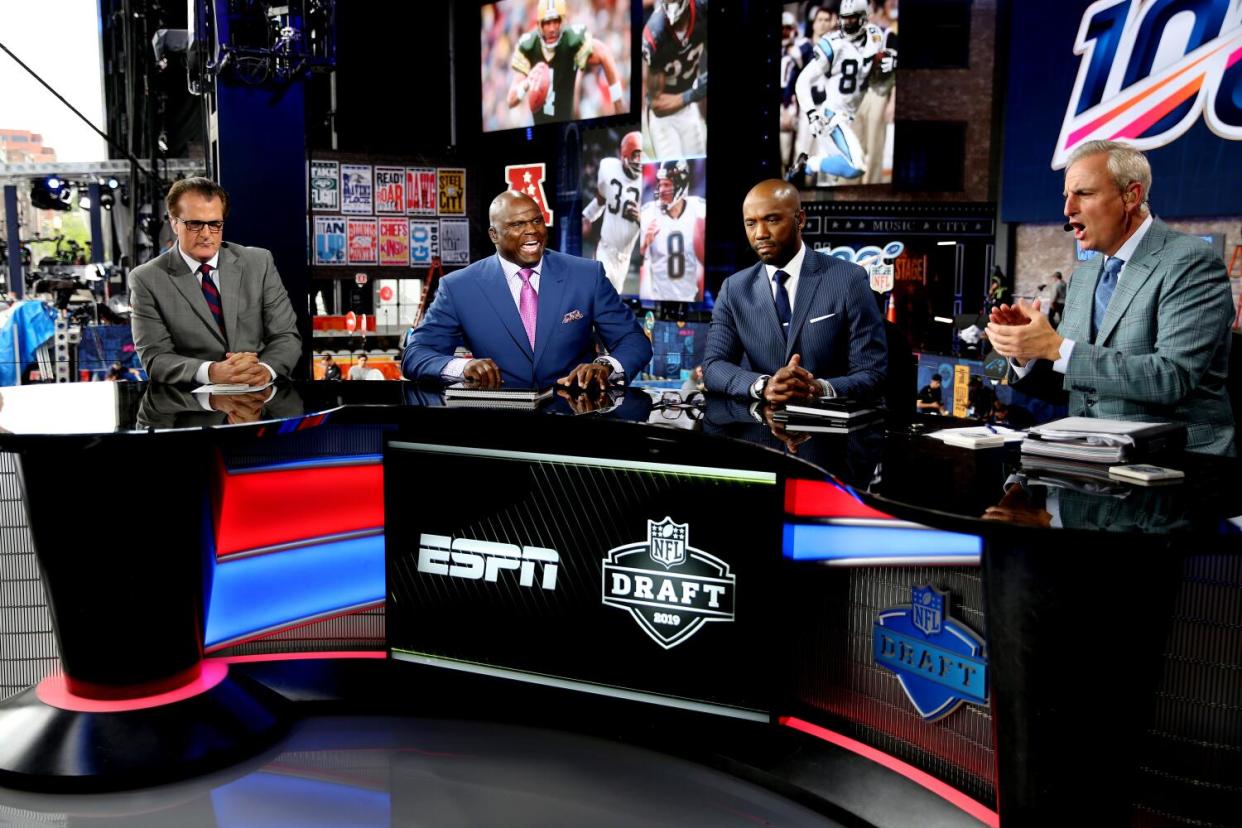
During his first 15 years running Walt Disney Co., Bob Iger had a magical touch.
Acquisitions of Pixar Animation, Marvel Entertainment and Lucasfilm turbocharged the company’s creative engines. Movies minted billions of dollars, sports king ESPN spawned staggering profits, and Disney’s theme parks teemed with delighted guests. Iger embraced the role of celebrity chief executive, flirting briefly with a bid for president. As the industry’s senior statesman, he was treated with reverence.
As media analyst Michael Nathanson noted during an earnings call earlier this month, Iger, during his first CEO stint, had presided over “one of the most amazing content cycles in film we’ve ever seen.”
But no longer.
“What are you doing … to fix the film slate?” Nathanson asked.
In the year since Iger returned to Disney to replace his beleaguered successor, Bob Chapek, he has been trying to fix one problem after another in nearly every corner of the Burbank behemoth. Disney’s organizational structure was broken. Expenses had soared. Disney’s faithful fans were furious about a series of price hikes at the vaunted theme parks, and Florida’s governor, presidential hopeful Ron DeSantis, was taking swipes, saying the company was too “woke.” Then, in May, 11,500 screenwriters went on strike, joined later by 160,000 actors.
The film business that Nathanson referred to, which powers Disney’s multifaceted business, has been of mounting concern. This month, Disney’s “The Marvels” opened in theaters to a tepid $46 million in ticket sales — a disappointing start for a film that cost more than $200 million, and the weakest yet for a Marvel Studios picture.
The uneven performance of Lucasfilm and Disney’s animation and live-action releases have also raised worries.
All that has made Iger’s second tenure a rough ride so far. Since the beginning of the year, Disney has eliminated 8,000 jobs as part of a company-wide effort to cut $7.5 billion in costs. Amid the decline of traditional TV, the company is considering selling ABC and its eight owned stations in addition to taking on a financial partner or two for the company’s ESPN sports empire.
Disney’s stock is trading at about half its value of nearly three years ago. Earlier this year, Iger vanquished a proxy fight challenge by activist investor Nelson Peltz. But now Peltz and former Marvel chairman Isaac “Ike” Perlmutter are circling again.
With movie and TV production stalled for much of the year, Disney was facing a frightening 2024, with gaps in its film slate and ABC’s lineup. Iger finally stepped in to lead the entertainment industry’s effort to broker a truce with striking writers, then actors, by offering contracts that included 5% to 7% pay hikes. The resolutions marked a stark departure from July, when Iger — from a picturesque Rocky Mountain retreat for millionaires and billionaires — said striking union members’ pay demands were “not realistic.”
When Disney employees gathered outdoors last month to celebrate the famed studio’s 100th birthday, dozens of striking actors — smoldering over the months-long contract stalemate — protested boisterously outside the mouse-eared walled compound, prompting Disney security to briefly close an entrance to the lot.
“You tell us you’re trying to negotiate with us, but instead, you’re throwing a big party?” a disgusted SAG-AFTRA strike captain, Jeff Torres, said at the time. “Dude, read the room.”
Read more:Disney at 100: Seven ways Walt’s company forever changed entertainment
The sour mood marks a sharp contrast from last November, when Chapek was dispatched by the board and Iger was welcomed as a returning hero.
“Investors are big fans of Bob Iger … given his history of leading Disney through major content acquisitions … and the pivot to streaming,” Wells Fargo media analyst Steven Cahall wrote the night Iger was rehired. “The Street will see him as a steady leader in uncertain times.”
That largely remains true. But the Disney that the 72-year-old executive now runs is different from the one he left — and it is confronting unique challenges. Two major forces have roiled Disney and other traditional entertainment companies: the rise of Netflix, followed by Iger’s 2017 decision to plunge the company head-first into streaming, an initiative that Iger launched with vigor before his departure.
“Bob came back to a business that had fundamentally changed,” his friend and former ABC colleague Ted Harbert said in an interview. “Sure, it was on his watch, but it was actually Netflix and the viewers that made the decision to change how media is consumed.”


TD Cowen media analyst Doug Creutz sounded a refrain that’s become common in Hollywood over the last year: “If he was thinking about his legacy, he should have stayed in retirement,” Creutz said.
Iger, through a spokesman, declined to comment for this story.
Disney has amassed more than $10 billion in streaming losses over the last four years, according to regulatory filings. Warner Bros., NBCUniversal and Paramount Global followed Disney’s lead, each spending billions of dollars to compete in the streaming wars.
Today’s bounty of streamers — stocked with tantalizing shows, including Disney+’s “The Mandalorian” and “Loki” — has led to a perilous decline of linear television. The industry’s cash cow has long been the billions of dollars that entertainment companies receive in monthly programming fees from pay-TV companies, including Charter Communications and DirecTV.
But now, the pay-TV business is teetering — a trend Iger saw coming before many others and now has a hand in accelerating. A decade ago, ESPN networks were distributed to more than 100 million U.S. homes. Now, the linear channels are available in fewer than 70 million.
“They took an industry model that made a lot of money, and they burned it to the ground,” Creutz said.


The move to streaming has created tensions. In September, for the first time in decades, Disney displayed weakness in contract negotiations, resulting in a 10-day blackout of Disney channels on Charter’s Spectrum cable service. Charter threatened to drop Disney’s channels for good before the two companies cobbled together an accord. Disney gave up distribution of Freeform and other small channels.
“There used to be a day when Bob Iger and Disney could stabilize the ground beneath them,” Marc Ganis, president of Sportscorp Ltd., said. “But that day has come and gone — for the whole industry. Technology has altered the foundation, and he can’t stabilize it the way he used to.”


TV executives recognize the future lies in streaming, and Iger and others have defended the aggressive push. Experts anticipate there will only be room for three to four dominant streaming services, and most think that Disney’s will be in the mix.
Iger knew the evolution would be painful.
In his 2019 book, “The Ride of a Lifetime,” Iger described the enthusiasm surrounding the decision two years earlier to buy a streaming platform to launch the streaming services, Disney+ and ESPN+. Board members signaled “speed was of the essence,” he wrote.
“We were now hastening the disruption of our own business, and the short-term losses were going to be significant,” he wrote.
Iger conceded that, initially, he wasn’t planning to be so bold.
“I’d assumed we would transition to the new model in baby steps, slowly building the apps and determining what content would live on them,” Iger wrote. But “because the response was so positive, the entire strategy took on a greater sense of urgency.”
Read more:Disney CEO Bob Iger touts streaming progress after a year of ‘fixing’
Iger negotiated a blockbuster deal to buy much of Rupert Murdoch’s 21st Century Fox. Investors cheered the move, which was designed to bolster Disney’s content arsenal. In March 2019, Disney finalized the $71.3-billion Fox purchase.
The deal saddled the company with billions of dollars of debt, and opinions are mixed over the wisdom of Iger’s play for Fox.
Peltz and Perlmutter have bemoaned the pricey purchase. Peltz, through his Trian Fund Management, accused Disney executives of exhibiting “poor judgment” by “materially overpaying.”
Read more:Disney got ‘The Simpsons’ and ‘Avatar.’ But some now see the Fox deal as a mistake
With the added content — including “Avatar,” “The Simpsons,” “Deadpool,” and FX and National Geographic channels — Disney geared up for its November 2019 launch of Disney+. During a presentation in a cavernous soundstage in Burbank earlier that year to unveil its streaming strategy, investors gasped when Disney announced the core service would be offered for just $6.99 a month.
Consumers loved the low price and Disney+ was an immediate hit.
Within five months of its launch, the COVID-19 pandemic settled in, dealing the rest of the company a devastating blow. Disney’s theme parks and cruise lines shut down, movie theaters went dark and ESPN struggled to fill time without live sports.
By this time, Iger had handed the CEO mantle to Chapek, but Iger remained on as executive chairman through 2021.
Read more:The cheap streaming era is over. Here’s why your bills are going up
During the 11 months Iger was away, Disney increased its content budget to drive streaming subscriptions, and financial losses soared. Chapek promised Wall Street that Disney+ would have more than 230 million subscribers by 2024.
Not even close. Disney+ had 112 million subscribers at the end of September, plus nearly 38 million from its Disney+ HotStar service in India.
Turning on the programming fire hose to feed the streaming platforms, in many ways, now haunts Disney.
Critics blame the production ramp up for stretching the studios and possibly damaging the Marvel, Pixar and Star Wars brands. The burnout isn’t just at the studio level: Visual effects (VFX) artists who work on Marvel productions say they are drained by the long hours to meet difficult deadlines.
Marvel Studios and Walt Disney Pictures VFX workers this fall voted to unionize under the International Alliance of Theatrical Stage Employees.
The mandate for Disney’s studios “to support both the theatrical window and Disney+ has overtaxed their creative engine,” Creutz, the analyst, said. “It’s very hard to scale quality.”
For two decades, Pixar popped out one blockbuster after another, including “Toy Story,” “Finding Nemo” and “WALL-E.” But recent efforts haven’t achieved the same levels of success. Its latest, “Elemental,” had a soft opening, but recovered in the weeks following its release, generating nearly $500 million in worldwide ticket sales.
Walt Disney Animation’s upcoming effort, “Wish,” a tribute to Disney’s 100-year legacy and its future, is coming out to mixed reviews.
But the Marvel Cinematic Universe has been stretched the most. Since the franchise’s peak in 2019 with “Avengers: Endgame,” the Kevin Feige-run superhero powerhouse has churned out multiple shows for Disney+, alongside its pipeline of several movies a year.
“There is simply too much Marvel content out there,” Terence McSweeney, a film scholar and teacher at Solent University in Britain who has written extensively about Marvel properties. “Instead of delighting fans as we might have expected it to, [the abundance] seems to have alienated many of them in recent years.”
Read more:What’s up with the MCU? A new book chronicles Marvel Studios’ reign and stumbles
Iger responded this month to concerns about lower quality at the studios. While Disney had four “really strong titles” in the last fiscal year, starting with “Avatar: The Way of Water,” Iger acknowledged during the Nov. 8 earnings call that “the pandemic created a lot of challenges creatively for everybody, including for us.”
Launching so many projects didn’t help either.
“I’ve always felt that quantity can be actually a negative when it comes to quality,” Iger said. “That’s exactly what happened. We lost some focus.”
The solution, he said, was to make fewer films, with a focus on high standards. In the next fiscal year, Disney plans to spend $25 billion on programming — $2 billion less than the just-ended fiscal year.
“We’re all rolling up our sleeves, including myself, to do just that,” he said. “We have obviously great assets [and] great stories to tell.”
Read more:Disney extends CEO Bob Iger’s contract through 2026, delaying retirement again
Iger returned last November with a two-year contract. But in July, Disney’s board extended his stay through 2026. The extension, the board said, “provides continuity of leadership during the company’s ongoing transformation.”
He has admitted that he needs time to tackle the myriad challenges, including preparing to take the flagship ESPN directly to consumers and finding equity partners that can also invest or help distribute the channel.
“They have to find ways to make up for the loss of revenue as cable subscriptions continue to fall,” Ganis, the sports analyst, said. “And they have to become more relevant to a younger audience that has never had cable or satellite TV.”
In the most recent quarter, Disney showed financial improvement. Streaming losses narrowed to $387 million, compared with the year earlier when it was $1.47 billion. The core Disney+ service added nearly 7 million subscribers, and executives reaffirmed that the streaming business, which includes Disney+, Hulu and ESPN+, would be profitable by the end of September, thanks in part to cost cuts and price hikes.


The company’s stock responded positively.
Iger’s biggest challenge might be the one that has vexed him the most: finding a successor.
He recently brought back two former top deputies, Kevin Mayer and Tom Staggs, as consultants to help him plot strategy for ESPN and possible financial deals. Both had left the company after being passed over for the top job, and joined forces to create the entertainment investment firm Candle Media.
Among potential internal candidates, there’s ESPN Chairman Jimmy Pitaro and the two Co-Chairmen of Disney Entertainment, Dana Walden, who oversees television, and Alan Bergman, the film chief.
“Who knows who will be the successor,” Yale School of Management associate dean Jeffrey Sonnenfeld said. “You could reach into that pool almost blindly and anyone who you would pull out could make a great successor.”
Disney is not expected to make that call for another year or two, and Iger has said he won’t be leaving until the company fully makes the streaming transition.
“While we still have work to do to continue improving results, our progress has allowed us to move beyond this period of fixing and begin building our businesses again,” Iger told investors earlier this month.
This story originally appeared in Los Angeles Times.